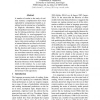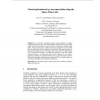158
click to vote
CDC
2010
IEEE
14 years 8 months ago
2010
IEEE
In this paper we study the human eye movement and the head movement system as a simple mechanical control system. Most of the time, eye movements obey Listing's constraint, wh...
111
Voted
CVPR
2011
IEEE
14 years 9 months ago
2011
IEEE
Human saccade is a dynamic process of information pursuit. Based on the principle of information maximization, we propose a computational model to simulate human saccadic scanpath...
162
Voted
AUGHUMAN
2010
14 years 11 months ago
2010
Our eyes collect a considerable amount of information when we use them to look at objects. In particular, eye movement allows us to gaze at an object and shows our level of intere...
105
Voted
ACL
2010
14 years 11 months ago
2010
A number of results in the study of realtime sentence comprehension have been explained by computational models as resulting from the rational use of probabilistic linguistic info...
107
click to vote
TOG
2002
15 years 18 days ago
2002
For an animated human face model to appear natural it should produce eye movements consistent with human ocular behavior. During face-to-face conversational interactions, eyes exh...
104
click to vote
IJON
2000
15 years 24 days ago
2000
A series of neurophysiological experiments on the responses of V1 neurons during saccadic eye movements were carried out. Strong suppression followed by rebound was observed in po...
IJON
2006
15 years 29 days ago
2006
We analyze the predictability of eye movements of observers viewing dynamic scenes. We first assess the effectiveness of model-based prediction. The model is divided into inter-sa...
90
Voted
BC
2006
15 years 1 months ago
2006
Abstract In primates, it is well known that there is a consistent relationship between the duration, peak velocity and amplitude of saccadic eye movements, known as the `main seque...
110
Voted
ICANN
2010
Springer
15 years 2 months ago
2010
Springer
Abstract. We investigate the extent to which eye movements in natural dynamic scenes can be predicted with a simple model of bottom-up saliency, which learns on different visual re...
175
Voted
GISCIENCE
2010
Springer
15 years 2 months ago
2010
Springer
Abstract. Eye movement recordings produce large quantities of spatiotemporal data, and are more and more frequently used as an aid to gain further insight into human thinking in us...




